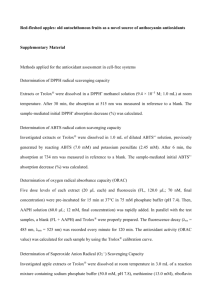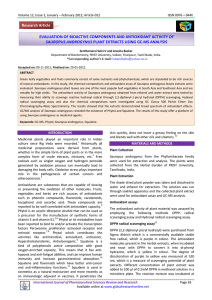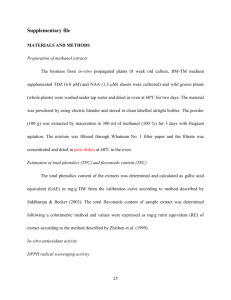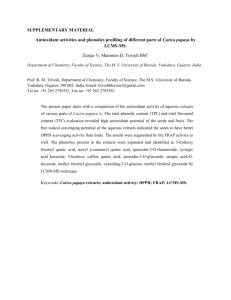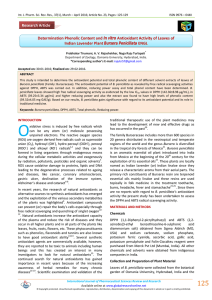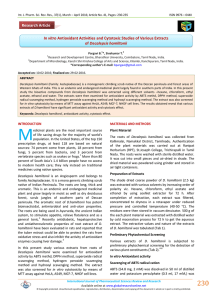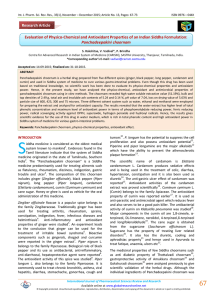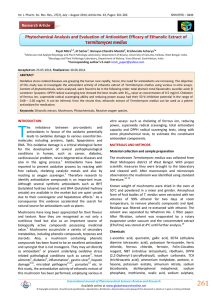Document 13308448
advertisement
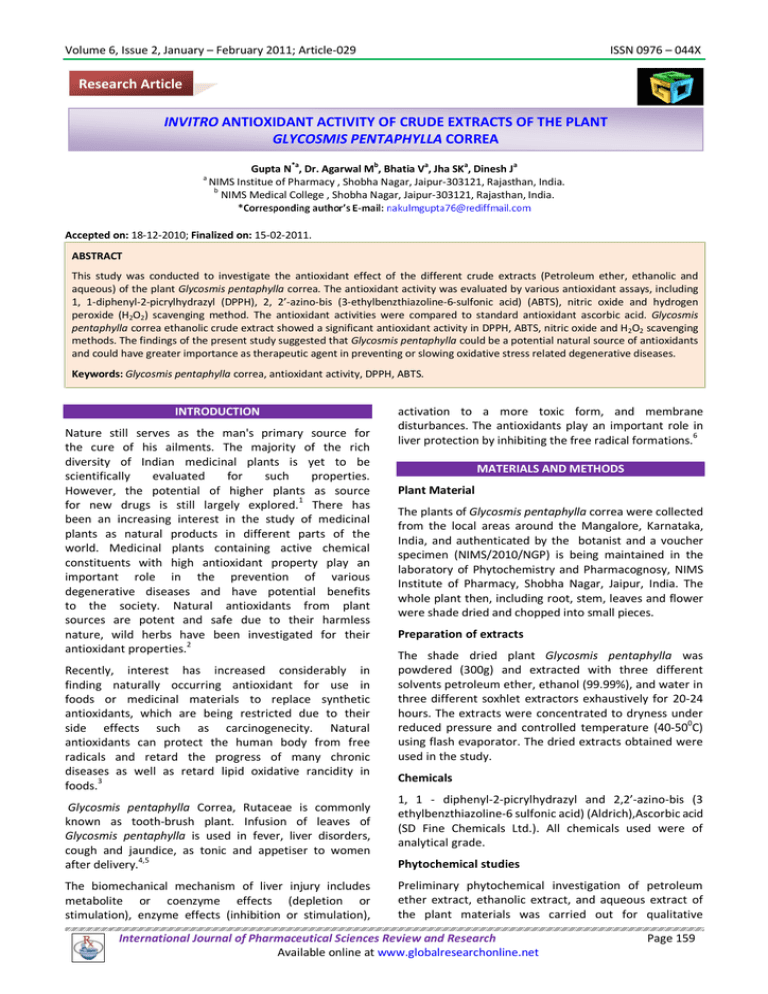
Volume 6, Issue 2, January – February 2011; Article-029
ISSN 0976 – 044X
Research Article
INVITRO ANTIOXIDANT ACTIVITY OF CRUDE EXTRACTS OF THE PLANT
GLYCOSMIS PENTAPHYLLA CORREA
*a
a
b
a
a
a
Gupta N , Dr. Agarwal M , Bhatia V , Jha SK , Dinesh J
NIMS Institue of Pharmacy , Shobha Nagar, Jaipur-303121, Rajasthan, India.
b
NIMS Medical College , Shobha Nagar, Jaipur-303121, Rajasthan, India.
Accepted on: 18-12-2010; Finalized on: 15-02-2011.
ABSTRACT
This study was conducted to investigate the antioxidant effect of the different crude extracts (Petroleum ether, ethanolic and
aqueous) of the plant Glycosmis pentaphylla correa. The antioxidant activity was evaluated by various antioxidant assays, including
1, 1-diphenyl-2-picrylhydrazyl (DPPH), 2, 2’-azino-bis (3-ethylbenzthiazoline-6-sulfonic acid) (ABTS), nitric oxide and hydrogen
peroxide (H2O2) scavenging method. The antioxidant activities were compared to standard antioxidant ascorbic acid. Glycosmis
pentaphylla correa ethanolic crude extract showed a significant antioxidant activity in DPPH, ABTS, nitric oxide and H2O2 scavenging
methods. The findings of the present study suggested that Glycosmis pentaphylla could be a potential natural source of antioxidants
and could have greater importance as therapeutic agent in preventing or slowing oxidative stress related degenerative diseases.
Keywords: Glycosmis pentaphylla correa, antioxidant activity, DPPH, ABTS.
INTRODUCTION
Nature still serves as the man's primary source for
the cure of his ailments. The majority of the rich
diversity of Indian medicinal plants is yet to be
scientifically
evaluated
for
such
properties.
However, the potential of higher plants as source
for new drugs is still largely explored.1 There has
been an increasing interest in the study of medicinal
plants as natural products in different parts of the
world. Medicinal plants containing active chemical
constituents with high antioxidant property play an
important role in the prevention of various
degenerative diseases and have potential benefits
to the society. Natural antioxidants from plant
sources are potent and safe due to their harmless
nature, wild herbs have been investigated for their
antioxidant properties.2
Recently, interest has increased considerably in
finding naturally occurring antioxidant for use in
foods or medicinal materials to replace synthetic
antioxidants, which are being restricted due to their
side effects such as carcinogenecity. Natural
antioxidants can protect the human body from free
radicals and retard the progress of many chronic
diseases as well as retard lipid oxidative rancidity in
3
foods.
Glycosmis pentaphylla Correa, Rutaceae is commonly
known as tooth-brush plant. Infusion of leaves of
Glycosmis pentaphylla is used in fever, liver disorders,
cough and jaundice, as tonic and appetiser to women
after delivery.4,5
The biomechanical mechanism of liver injury includes
metabolite or coenzyme effects (depletion or
stimulation), enzyme effects (inhibition or stimulation),
activation to a more toxic form, and membrane
disturbances. The antioxidants play an important role in
liver protection by inhibiting the free radical formations.6
MATERIALS AND METHODS
Plant Material
The plants of Glycosmis pentaphylla correa were collected
from the local areas around the Mangalore, Karnataka,
India, and authenticated by the botanist and a voucher
specimen (NIMS/2010/NGP) is being maintained in the
laboratory of Phytochemistry and Pharmacognosy, NIMS
Institute of Pharmacy, Shobha Nagar, Jaipur, India. The
whole plant then, including root, stem, leaves and flower
were shade dried and chopped into small pieces.
Preparation of extracts
The shade dried plant Glycosmis pentaphylla was
powdered (300g) and extracted with three different
solvents petroleum ether, ethanol (99.99%), and water in
three different soxhlet extractors exhaustively for 20-24
hours. The extracts were concentrated to dryness under
reduced pressure and controlled temperature (40-500C)
using flash evaporator. The dried extracts obtained were
used in the study.
Chemicals
1, 1 - diphenyl-2-picrylhydrazyl and 2,2’-azino-bis (3
ethylbenzthiazoline-6 sulfonic acid) (Aldrich),Ascorbic acid
(SD Fine Chemicals Ltd.). All chemicals used were of
analytical grade.
Phytochemical studies
Preliminary phytochemical investigation of petroleum
ether extract, ethanolic extract, and aqueous extract of
the plant materials was carried out for qualitative
International Journal of Pharmaceutical Sciences Review and Research
Available online at www.globalresearchonline.net
Page 159
Volume 6, Issue 2, January – February 2011; Article-029
determination of the groups of organic compounds
present in them, by using different tests for Alkaloids,
Carbohydrates, Proteins, Steroids etc.8
DPPH radical scavenging activity
DPPH assay is based on the measurement of the
scavenging ability of antioxidant towards the stable DPPH
radical. The assay was carried out in a 96 well microtitre
plate. To 100 µl of DPPH solution, 10 µl of various
concentrations of the extract or the standard solution
was added separately in wells of the microtitre plate. The
plates were incubated at 37ºC for 30 min. and
absorbance was measured at 490 nm using ELISA reader.9
ABTS radical cation decolourisation assay
ABTS (54.8 mg) was dissolved in 50ml of distilled water to
2mM concentration and potassium persulphate (17 mM,
0.3 ml) was added. The reaction mixture was left to stand
at room temperature overnight in dark before use. To 0.2
ml of various concentrations of the extracts or standards,
1.0 ml of distilled DMSO and 0.16 ml of ABTS solution was
added to make a final volume of 1.36 ml. Absorbance was
measured spectrophotometrically, after 20 minutes at
734nm.10
Scavenging of nitric oxide
Sodium nitroprusside (5µM) in std. phosphate buffer
solution was incubated with different concentration of
the test extracts dissolved in standard phosphate buffer
(0.025M, pH 7.4) and the tubes were incubated at 25°C
for 5 hr. After 5 h, 0.5 ml of incubation solution was
removed and diluted with 0.5 ml Griess reagent (prepared
by mixing equal volume of 1% sulphanilamide in 2%
phosphoric acid and 0.1% naphthylethylene diamine
dihydrochloride in water). The absorbance of
chromophore formed was read at 546 nm. The control
experiment was also carried out in similar manner, using
distilled water in the place of extracts. The activity was
compared with ascorbic acid, which was used as a
standard antioxidant.11,12
Scavenging of hydrogen peroxide
A solution of hydrogen peroxide (20mM) was prepared in
phosphate buffered saline (PBS, pH 7.4). Various
concentrations of 1ml of the extracts or standards in
methanol were added to 2 ml of hydrogen peroxide
solutions in PBS. The absorbance was measured at 230
nm, after 10 min against a blank solution that contained
extracts in PBS without hydrogen peroxide.13
IC50 value is the concentration of the sample required to
scavenge 50 % free radical. The above experiments were
performed (in triplicate) and the percentage inhibition
was calculated by using the following formula.14
Scavenging activity (%) = [{OD control - OD sample}/ OD control] x 100
ISSN 0976 – 044X
RESULTS AND DISCUSION
The percentage yield of petroleum ether, ethanolic and
aqueous extracts was found to be 9.8, 11.4 and 14.6.
Preliminary phytochemical screening of the crude extracts
of the plant Glycosmis pentaphylla showed the presence
of steroids, alkaloids, glycosides, saponins, flavonoids,
tannins and carbohydrates.
DPPH assay is based on the measurement of the
scavenging ability of antioxidant towards the stable DPPH
radical. DPPH is relatively stable nitrogen centered free
radical that can accept an electron or hydrogen radical to
become a stable diamagnetic molecule. DPPH radicals
react with suitable reducing agent as a result of which
electron become paired off forming the corresponding
hydrazine. The solution therefore looses colour
stoichometrically depending on the number of electrons
consumed which is measured spectrometrically at 517
15
nm. From results it may be postulated that extracts of
Glycosmis pentaphylla have hydrogen donors, thus
scavenge free radical DPPH.
The principle behind the ABTS assay technique involves
the reaction between ABTS and potassium persulphate to
produce the ABTS radical cation (ABTS+) a blue green
chromogen. In the presence of antioxidant reductant, the
coloured radical is converted back to colourless ABTS, the
absorbance of which is measured at 734nm. The extracts
of Glycosmis pentaphylla possessed antioxidant activity
with maximum IC50 value being 26.2mcg/ml for ethanolic
extract suggest the free radical scavenging activity.
The absorbance of the chromophore formed during
diazotization of the nitrite with sulphanilamide and
subsequent coupling with napthylethylene diamine is used
as the marker for NO scavenging activity.16 The
chromophore formation was not complete in the presence
of Glycosmis pentaphylla extract, which scavenges the NO
thus formed from the sodium nitroprusside and hence the
absorbance decreases as the concentration of the extracts
increases.
H2O2 is a weak oxidizing agent and can inactivate a few
enzymes directly, usually by oxidation of essential thiol (SH) groups. Hydrogen peroxide can cross cell membrane
rapidly. Once inside the cell, H2O2 can probably react with
Fe+2 and possibly Cu+2 to form hydroxyl radical and this
may be the origin of many of its toxic effects. It is
therefore biologically advantageous for cells to control the
amount of hydrogen peroxide that is allowed to
accumulate. The decomposition of H2O2 by extracts of
Glycosmis pentaphylla may result from its antioxidant and
free radical scavenging activity.
Results obtained in the present study indicate that
extracts of Glycosmis pentaphylla showed a free radical
scavenging activity but ethanolic extract showed the
maximum antioxidant activity which was significantly
comparable to free radical scavenging activity of ascorbic
acid. (Table & Figure 1-4).
International Journal of Pharmaceutical Sciences Review and Research
Available online at www.globalresearchonline.net
Page 160
Volume 6, Issue 2, January – February 2011; Article-029
ISSN 0976 – 044X
Table 1: DPPH scavenging activity of extracts of Glycosmis pentaphylla
Sample
Petroleum ether extract
Ethanol extract
Aqueous extract
Ascorbic acid
10µg/ml
17.71 ± 1.29**
20.83 ± 1.93**
12.21 ± 2.14
DPPH Percentage scavenging (Mean ± SEM ) of triplicates
20µg/ml
30µg/ml
40µg/ml
50µg/ml
36.23 ± 1.72** 50.52 ± 3.02** 68.00 ± 3.19**
79.71 ± 3.22**
40.46 ± 2.55** 53.54 ± 3.09** 71.34 ± 1.91**
85.02 ± 3.05**
29.53 ± 1.85
41.21 ± 2.46
51.72 ± 2.68
67.17 ± 1.45
24.73 ± 1.84
48.64 ± 3.39
64.64 ± 3.80
77.23 ± 5.12
IC50
30
28.5
38.5
92.09 ± 4.36
23
Table 2: ABTS scavenging activity of extracts of Glycosmis pentaphylla
Petroleum ether extract
Ethanol extract
ABTS Percentage scavenging (Mean ± SEM ) of triplicates
10µg/ml
20µg/ml
30µg/ml
40µg/ml
50µg/ml
17.24 ± 1.13**
31.21 ± 2.02**
54.75 ± 2.03**
68.43 ± 1.62**
74.21 ± 1.81**
22.43 ± 1.36**
42.45 ± 2.43**
59.11 ± 2.34**
72.96 ± 3.13**
79.74 ± 3.53**
29.8
26.2
Aqueous extract
Ascorbic acid
13.52 ± 1.04**
28.47 ± 1.24
33.6
22.8
Sample
26.17 ± 1.27**
48.32 ± 2.05
46.31 ± 1.83**
64.19 ± 3.95
60.91 ± 2.13**
71.89 ± 2.98
IC50
66.63 ± 3.27**
78.18 ± 2.85
Table 3: NO radical scavenging activity of different extracts of Glycosmis pentaphylla
Nitric oxide radical scavenging (Mean ± SEM ) of triplicates
Sample
Petroleum ether extract
Ethanol extract
Aqueous extract
Ascorbic acid
10µg/ml
28.76 ± 1.19
32.97 ± 0.93
26.98 ± 0.89
38.55 ± 0.94
20µg/ml
38.98 ± 1.95
43.65 ± 2.01
36.36 ± 1.79
43.06 ± 1.82
30µg/ml
45.42 ± 2.03
49.51 ± 1.45
42.05 ± 0.93
54.32 ± 1.93
40µg/ml
50.98 ± 2.95
54.19 ± 2.07
48.94 ± 2.97
57.42 ± 1.75
50µg/ml
55.86 ± 1.93
61.06 ± 2.35
52.07 ± 1.86
65.21 ± 3.04
IC50
36.5
31.0
41.5
24.0
Table 4: Hydroxyl radical scavenging activity of different extracts of Glycosmis pentaphylla
Sample
Petroleum ether extract
Ethanol extract
Aqueous extract
Ascorbic acid
Hydroxyl radical scavenging (Mean ± SEM ) of triplicates
10µg/ml
20µg/ml
30µg/ml
40µg/ml
50µg/ml
16.62 ± 2.31**
29.24 ± 2.92** 39.49 ± 1.74** 51.34 ± 2.32**
60.15 ± 2.48**
26.12 ± 0.53**
42.24 ± 1.19** 55.21 ± 3.45** 64.53 ± 2.53** 70.37 ± 2.47**
12.38 ± 0.59**
20.63 ± 1.93** 32.75 ± 2.38** 42.49 ± 1.29** 51.08 ± 2.98**
38.73 ± 0.97
52.85 ± 1.85
64.19 ± 3.95
71.89 ± 2.98
International Journal of Pharmaceutical Sciences Review and Research
Available online at www.globalresearchonline.net
78.18 ± 2.85
IC50
38.1
26.2
48.0
18.3
Page 161
Volume 6, Issue 2, January – February 2011; Article-029
CONCLUSION
The results obtained in present study indicate that
extracts of Glycosmis pentaphylla inhibits free radical
scavenging activity and have hepatoprotective action
also. The overall antioxidant and hepatoprotective
activity of Glycosmis pentaphylla extract might be
attributed to its triterpenoid and polyphenolic content
and other phytochemical constituents. It could be a
source of natural antioxidant that could have greater
importance as therapeutic agent in preventing or slowing
oxidative stress related degenerative diseases.
Acknowledgements: The authors wish to thank the
management of NIMS institute of Pharmacy, NIMS
University, Jaipur for providing financial support and for
encouraging and providing research facilities.
REFERENCES
1.
Oke JM, Hamburger MO. “Screening of some
nigerian medicinal plants for antioxidant activity
using 2, 2, diphenyl-picryl-hydrazyl radical”, African
Journal of Biomedical Res, 2002; l5; 77 – 79.
2.
Hakkim L, Arivazhagan G, Boopathy R, “ J. Med.
Plants Res”, 2008; 2(9); 250-257.
3.
Lai LS, Chou ST, Chao WW. “Studies on the
antioxidative activities of hsian-tsao (Mesona
procumbens Hemsl) leaf gum”, Journal of
Agricultural and Food Chemistry, 2001; 49; 963–
968.
4.
Chakravarty AK, Das B, Masuda KR, Ageta H;
Chemical and Pharmaceutical Bulletin, 1996; 44(7);
421-123.
5.
Kirthikar KR, Basu BD; Indian medicinal plants. 3rd
vol, International book distributors, Deharadun,
India, 1991; 469-70.
6.
Slater TF; Biochemical studies on liver injury.
Academic press inc (London) ltd, London, 1978; 1139.
ISSN 0976 – 044X
7.
Kokate CK; Pharmacognosy. 9th edi, Nirali
Prakashan, Pune, 1998; 446-449.
8.
Hwang, et al. “Antioxidant benzoylated flavan-3-ol
glycoside from Celastrus orbiculatus”, J. Nat. Prod,
2001; 64(1); 83.
9.
Re R, et al. “Antioxidant activity applying an
improved ABTS radical cation decolorisation
assay”, Free Radical Biology and Medicine, 1999;
26: 1231-1237.
10. Jayaprakasha GK, et al. “Antioxidant activities of
Flavidin in Different Invitro Model Systems”,
Bioorganic and Med Chem, 2004; 12; 5141-5146.
11. Munir O, et al. “Determination of in vitro
antioxidant activity of fennel seed extracts”,
Lebensm-Wiss.U-Technol, 2003; 36; 263-271.
12. Mruthunjaya K, Hukkeri VI. “In vitro antioxidant
and free radical scavenging potential of
Parkinsonia aculeate Linn”, Pharmacognosy
Magazine, 2008; 4; 42-51.
13. Badami S, et al. “In vitro activity of various extracts
of Aristolochia bracteolate leaves”, Oriental
Pharmacy and Exp Med, 2005; 5; 316-321.
14. Halliwell B. “Reactive oxygen species in living
systems: Source biochemistry and role in human
disease”, American J of Med, 1991; 91; 14-22.
15. Mukherjee KL; Medical laboratory technology. 1st
edi, Tata McGraw Hill Publishing Company limited,
New delhi, 1989; 1124-1127.
16. Ahsan R, Islam M, Musaddik A Haque E.
“Hepatoprotective Activity of Methanol Extract of
Some
Medicinal
Plants
Against
Carbon
tetrachloride Induced Hepatotoxicity in Albino
Rats”, Global J of Pharmacol, 2009; 3(3); 116-122.
About Corresponding Author: Mr. Nakul Gupta
Mr. Nakul Gupta graduated at BBDNIT&M, Lucknow, Agra university, and post graduated from
NGSM Institute of Pharmaceutical Sciences, RGUHS, Karnataka. At post graduation level taken
specialization in pharmacology and currently doing PhD. in Pharmacology from Vinayaka
Missions University, Tamilnadu. Presently working as an associate professor at NIMS
University, Jaipur in the department of Pharmacology.
International Journal of Pharmaceutical Sciences Review and Research
Available online at www.globalresearchonline.net
Page 162

